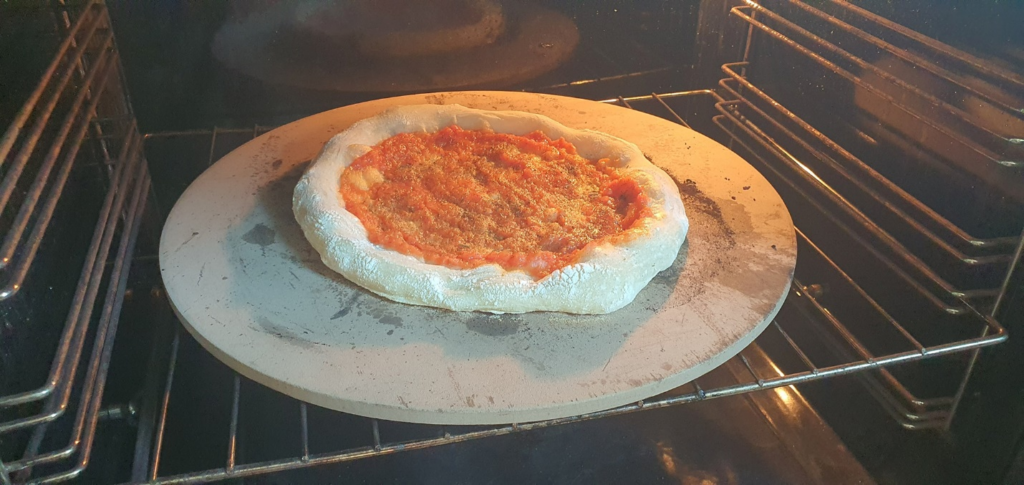A pizza stone is a flat, usually circular slab made of ceramic, cordierite, clay, or sometimes even salt or steel. It’s primarily used for baking pizza but can also be used for bread, pastries, and other baked goods.
When you place it in an oven or a grill, it absorbs heat and then evenly distributes that heat to the food placed on it. This results in a crispy crust and well-cooked toppings, mimicking the effect of a brick oven. For BBQ, Smoker, Traeger, and Green Egg enthusiasts, check out our top recommended Pizza Stones for Grills.
When using a pizza stone on a grill, here’s what you need to know:
Preheat: Always preheat the Stone with the Grill. This ensures that the pizza starts cooking immediately upon contact, which helps create a crispy crust.
Even Cooking: The Stone’s thermal mass helps in even cooking, reducing the chances of hot spots that can burn your crust. This is especially useful in grills, which can sometimes have uneven heating.
Handling: Pizza stones can be very hot, so always use heat-resistant gloves or mitts when handling. Also, they can be brittle and can crack if subjected to sudden temperature changes. Avoid placing a cold stone on a hot grill or vice versa.
Cleaning: It’s usually best to clean a pizza stone with just a brush or scraper. Avoid using soap, as the porous nature of the Stone can absorb it, leading to soapy-tasting food later.
Benefits for Grills: The Stone acts as a barrier between the direct flames or heat source and the pizza. This prevents the bottom crust from burning before the toppings are done, especially in grills that are very hot and direct.
Types of Grills: Pizza stones can be used on both gas grills and charcoal grills. When using with charcoal grills, make sure to set up an even bed of coals to ensure uniform heat under the Stone.
How to use a pizza stone for a Grill?

Using a pizza stone on a grill can give you a delightful crust that’s difficult to achieve with conventional oven baking. Here’s a step-by-step guide on how to use a pizza stone on a grill:
Choose the Right Stone: Ensure your pizza stone is designed for high temperatures and is suitable for grill use. Some stones are meant just for ovens and might crack on a grill.
Preheat the Grill with the Stone Inside: Place the pizza stone on the grill grates and preheat the Grill to the desired temperature, typically between 450°F (232°C) and 500°F (260°C). You want the Stone to heat up gradually with the Grill to prevent cracking from sudden temperature changes.
Prepare Your Pizza: While the Grill is preheating, prepare your pizza on a pizza peel or an inverted baking sheet. Using cornmeal or flour on the peel will help the pizza slide off easily onto the Stone.
Transfer the Pizza: Once the Grill (and Stone) is preheated, slide your pizza onto the Stone. If you’re using a pizza peel, give it a little shake to make sure the pizza isn’t sticking before you slide it onto the Stone.
Monitor Cooking: Close the grill lid to retain heat. Cook the pizza for about 5-10 minutes, depending on its size and thickness, as well as the actual temperature of the Grill. Check the pizza periodically. If you notice that one side is cooking faster than the other, rotate the pizza for even cooking.
Remove the Pizza: When the crust is golden brown and the cheese is melted and bubbly, your pizza is ready. Use the pizza peel or a large spatula to remove the pizza from the Stone.
Let the Stone Cool: After you’re done cooking, turn off the Grill and let the Stone cool down inside it. Avoid exposing the hot Stone to cold temperatures or water, as it can crack.
Cleaning: Once the Stone has cooled, clean it using a brush or scraper. It’s normal for pizza stones to develop dark spots and discolorations over time. Avoid using soapy water, as the Stone can absorb the soap and impart a soapy taste to your food.
